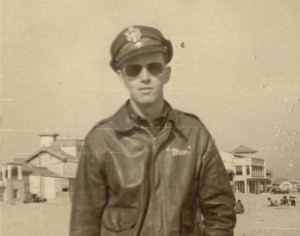Each name on a War Memorial has a life story. Before I joined NanoWrimo, I had written many stories. Here is my story of how I wrote Shrapnel – a November story – a Memorial Story for my family to read:
For twenty years or more, I had been lugging my father’s W WII letters in boxes through a series of moves. After sorting and scanning them, I was intrigued that his letters home gave more baseball reports than bombing actions.
WII letters in boxes through a series of moves. After sorting and scanning them, I was intrigued that his letters home gave more baseball reports than bombing actions.
I had decided to investigate this ‘baseball’ thing and discovered that it was actually an Army strategy to help the men keep sane during wartime, and later, transition them to civilian life.
Poking through what my mother had saved in a bottom bureau drawer I later discovered a leather pocket book. It contained a small trove of letters sent to my father from the families of his crew – the crew he trained with in Texas, the crew he thought he’d fly with over Berlin, the crew that went down on their first mission with their experienced pilot while Dad watched from his plane – he, the green co-pilot with an experienced crew.
These letters changed everything I was thinking.
The letters were thank you letters. To a lieutenant who took the time to write, give families hope, information that the telegram did not, and comfort, sorely needed. The single surviving crewman was liberated from a POW camp — 20 days after the crash and two weeks before the end of the war in Europe.
What the home letters revealed was the range of emotions: confusion, pain, grief, determination, acceptance, denial. I found that these feelings surfaced in contemporary newspaper reports of the families who lost soldiers in Iraq. I thought about the contrast and similarities between family grief at the loss of son/daughter and the soldiers’ grief at losing their buddies.

Bombing Mission Target
I never knew that Dad had written to the families; Mom knew. Obviously, he had told her a lot about his experiences. And, for us kids, Dad, like other WWII veterans, did not talk about the war.
If and when he did – it was a one liner. Yes, he flew to Berlin. What amazed him was that as he was returning to England, waves of bombers were just leaving. Yes, he flew prisoners of war to Spain. They were just bags of bones. Yes, when he came home, he walked up Edward Avenue and no one knew him – he only weighed 135 pounds. He was a walking stick.
As a result of those letters, my research for a story changed. I pulled my father’s flight records and tracked down all the missions. I read about Grafton-Underwood. I read whatever I could about the airmen who flew the bombers. I watched and listened to the documentary by Ken Burns. Particularly to the airmen’s experiences. I re-read letters from my friend who was killed in Viet Nam. I read fiction authors who wrote about other wars – the Civil War, the Great War. I clipped out newspaper accounts of the Iraq and Afghanistan casualties, particularly accounts of their families. I read and recorded reactions of families who received remains of their WWII airmen recovered from the Pacific after 60 years. I toured the insides of the B-17 and B-24 Liberator at the Beverly Airport. I hunted down LIFE magazine articles and photos of the end of the war. I read obituaries.
I kept thinking about contrasts. Dad’s letters from two years of training – the idealism, the frustrations, the impatience, the pride. From the front: thanks, baseball, and home. I had to find flight reality in books, documentaries, and biographies. I had to imagine what it might be like and so I created a story about Loot and Maxie and their flying crew based on Dad’s story.
While the family thank you letters inspired me, the crew and family feelings and stories in my story were fiction. What I found unified families then and now – is dealing with ‘no body.’ In some cases, no body means no closure, an open wound that cannot heal. In others, no body creates a struggle that the future must heal.
For the airmen, no body is the horror of returning to empty cots. Some men learned to distance themselves, focus on their jobs, their survival. Some men waked their losses with humor and stories. Some never recovered.
Yet, one veteran wrote to LIFE magazine in 1945 expressing his horror that the Army was considering a suggestion that bodies buried in the Pacific be disinterred and returned to their families. He averred that men who fought side by side and died side by side would want to remain buried side by side. For the men slogging onto bloody beaches, the War was really about the loyalty, the bravery, and the bond to those fighting beside you. Those Pacific burial grounds were sacred to the blood shared.
While those of us who have never experienced War, yet know loss, we can understand the shrapnel that cuts into Life. That explodes and hurts us, changes and strengthens us, gouges and defines us.
And, I think as scarring as losing his crew was, those letters to their families helped my Dad. My mother understood that. I wonder if she also saw God’s hand…Dad was shocked by the bombing destruction, the impact on the ordinary people. He stayed for the occupation – one year in the south of France. When he returned home, he continued that rebuilding; he spent 32 years providing public housing and housing programs to the poor, disenfranchised, the disabled, the veterans. God works in mysterious ways!









